Cards In This Set
| Front | Back |
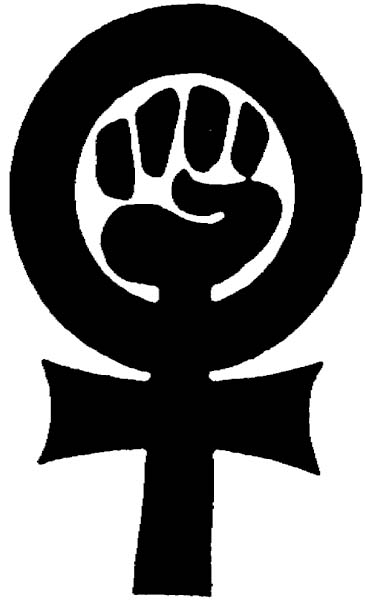 Feminism, according to the Oxford English Dictionary is 'the advocacy of women’s rights on the ground of the equality of the sexes' |
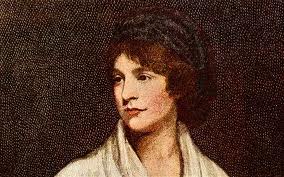 The First Wave of Feminism (Liberal) The American Declaration of Independence 1776 proclaimed 'We hold these truths to be self-evident; that all men are created equal'. The political and economic exclusion of women during period ignited the first wave of feminism which aimed to achieve formal equality through securing equal political rights and privileges. Mary Wollstonecraft's 'Vindication of the Rights of Women' published in 1796 argued women were, like men, essentially rational beings and therefore capable of self determination and as deserving of liberty, rights and, above all, education. The Prime Minister Horace Walpole responded by stating political rights for women were unnatural and he depicted Wollstonecraft as 'a hyena in petticoats'. John Stuart Mill, an advocate of liberal feminism wrote, in partnership with Harriet Taylor's 'On the Subjection of Women' which encouraged the government of the day to pass the Married Women's Property Act 1870 which for the first time, gave married women the right to own property, previously, everything they possessed legally belonged to their husbands. At the turn of the nineteenth century feminists divided due to differing beliefs in how to secure equal suffrage for women. Millicent Fawcett's 'National Union of Women's Suffrage Society' offered help and support to any Liberal MP who would promise to vote for the enfranchisement of women. Conversely Emmeline Pankhurst's 'Women's Social and Political Union' employed militant methods so the government could not turn a blind eye, one suffragette exclaimed “we have tried demonstrations, and now at last we have to break windows. I wish I had broken more." This accumulated in the death of Emily Davison who jumped in front of King George V's horse sacrificing her life to show the desire and the need for women's suffrage. Women in Britain over thirty were given the right to vote in 1918: the vote was extended to women over twenty-one, the same voting ages as men, in 1928. |
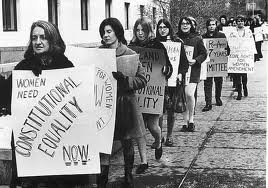 The Second Wave of Feminism (Liberal) By the 1960s, it was widely perceived the expansion of suffrage had done little to reduce ongoing economic, political, legal and social inequalities between men and women. So came the second wave of feminism. In the 'Feminine Mystique' (1963), the American Betty Friedan, on the basis of research acquired through the distribution of questionnaires found millions of women were discontent, feeling trapped in the home, unfulfilled by a life dominated by day to day domestic concerns. The answer was equal political and legal rights for women. Liberal feminists made considerable strides in the UK, with legislation such as the Abortion Act 1967. Equal Pay Act 1970, Sex Discrimination Act 1976, liberalization of divorce, taxation and property laws and the state provisions of free and legal contraception. Liberal feminists in the USA even managed to secure legislation of positive discrimination- that is, quotas- for women as well as ethnic minorities in education and employment. |
However, the liberal feminists movements was predominantly white, Western and middle class and broadly excluded working class and black women who were much more socially deprived. Gender inequalities across all classes continued leading to more radical forms of feminism emerging.
|
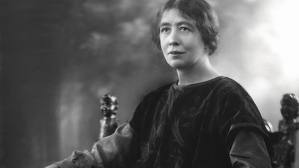 Marxist Feminism Theorists; Sylvia Pankhurst, Anne Philips and Lynne Segal. Sexual division in capitalism are due primarily to the operation of the economy, and therefore, that a class revolution is the prerequisite of sexual equality. Socialist feminism began with the nineteenth century Utopian socialists such as Charles Fourier, who argued for the abolition of oppressive, monogamous marriage in favor of short-term sexual liaisons in cooperative communities where housework and child-rearing would be done by specialists. In 'The Origins of the Family' Engels argued the orthodox nuclear family is an economic unit bound up with the male ownership and inheritance of private property. Women themselves have long been the property of men within the legal framework of marriage, which in turn has been a contract between the male breadwinner and the housewife of economic maintenance in return for sexual services. This is why, until the 1990s there was no legal concept of rape within marriage. Social feminists stress the role of women as a reserve army of labor in the event of an expansion of production such as in war. Women still provide a predominantly temporary and disposable source labor , socially conditioned to accept low pay and status, thereby depressing wage levels without threatening men's jobs. Women's domestic work is also essential to the health and efficiency of the state in sustaining and servicing their male partners, nurturing and conditioning future male workers and releasing men for employment. The traditional nuclear family with the male breadwinner and the female housekeeper provide Capitalism with 'two for the price of one'. The family also give men an incentive to remain in exploitative work to ensure its survival. Marxist feminists emphasize the role of ideology and socialization in perpetuating gender inequalities and women's acceptance of them. |
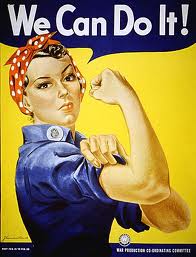 Radical Feminism Theorists; Kate Millet, Andrea Dworkin & Catherine MacKinnon. Radical feminists argue the primacy of gender divisions over all other social cleavages, including class and race. Kate Millet and Shulamith Firestone argue patriarchy in the personal and political sphere of home and family, have always been the first and most important power relationship in the human social system. Patriarchy in the private sphere confines most women to the home and therefore largely excludes them from the public sphere of work, economics and politics and is therefore the root of sexual inequality throughout society and indeed, throughout human history. Radicals make a distinction between one's sex, biological differences deriving through nature and gender, socially constructed roles which both men and women internalize through conditioning form birth. As Simone de Beauvoir stated 'One is not born, but rather becomes, a woman. No biological, psychological or economic fate determines the figure that the female presents in society; it is civilization a whole that produces this creature." Radical feminists wish to ignite a sexual revolution which will transform gender roles and eliminate private patriarchy. Unlike there liberal counterparts they see the pursuit of equality within an existing political framework as self defeating, because all political institutions had been created for men by men. Some radical feminists are careful to distinguish between male power and individual men. However, others believe patriarchal traits are so intensely woven into society it is increasingly difficult, nigh impossible for men not to be effected, consequently the only way in which to ensure liberation is through lesbian separatism. |
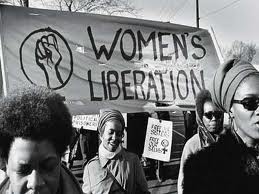 Black Feminism Theorists; bell hooks, Angela Davis & Heidi Mirza. Black Feminism argues that sexism, class oppression, and racism are inextricably bound together.One of the theories that evolved out of the Black feminist movement was Alice Walker's Womanism. Alice Walker and other womanists pointed out that black women experienced a different and more intense kind of oppression from that of white women. They point to the emergence black feminism after earlier movements led by white middle-class women which they regard as having largely ignored oppression based on race and class. Black feminists contend that the liberation of black women entails freedom for all people, since it would require the end of racism, sexism, and class oppression, this is why bell hooks proclaimed “feminism is for everybody” . There is a long-standing and important alliance between postcolonial feminists, which overlaps with transnational feminism and third-world-feminism, and black feminists. Both have struggled for recognition, not only from men in their own culture, but also from Western feminists.Black women faced the same struggles as white women; however, they had to face issues of diversity on top of inequality. Black feminist organizations emerged during the 1970s and face many difficulties from both the culture they were confronting and their adjustment to their vulnerability within it. These women also fought against suppression from the larger movements in which many of its members came from. Recent black feminism as a political/social movement grew out of black women's feelings of discontent with both the civil rights movement and the feminist movement of the 1960s and 1970s. Not only did the civil rights movement primarily focus only on the oppression of black men, but many black women faced severe sexism within civil rights groups such as the Student Nonviolent Coordinating Committee. The feminist movement focused on the problems faced by white women. For instance, earning the power to work outside of the home was not an accomplishment for black feminists; they had been working all along. Neither movement confronted the issues that concerned black women specifically. |
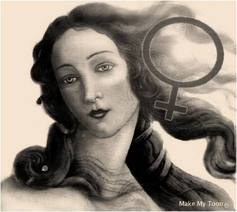 Postmodern Feminism Theorists; Judith Butler, Julia Kristeva and Joan Scott Postmodern Feminists have built on the ideas of Foucault, de Beauvoir, as well as Derrida and Lacan (who I'm not going to talk about). While there is much variation in Postmodern feminism, there is some common ground. Postmodern Feminists accept the male/female binary as a main categorizing force in our society. Following Simone de Beauvoir, they see female as having being cast into the role of the Other. They criticize the structure of society and the dominant order, especially in its patriarchal aspects. Many Postmodern feminists, however, reject the feminist label, because anything that ends with an "ism" reflects an essentialist conception. Postmodern Feminism is the ultimate acceptor of diversity. Multiple truths, multiple roles, multiple realities are part of its focus. There is a rejectance of an essential nature of women, of one-way to be a woman." Poststructural feminism offers a useful philosophy for diversity in feminism because of its acceptance of multiple truths and rejection of essentialism.Julia Kristeva rejects the idea that the biological man and the biological woman are identified with the "masculine" and "feminine" respectively. To insist that people are different because of their anatomy is to force both men and women into a repressive structure. Kristeva openly accepts the label of feminist, but refuses to say there is a "woman's perspective": "The belief that 'one is a woman' is almost as absurd and obscurantist as the belief that 'one is a man.' I say 'almost' because there are still many goals which women can achieve: freedom of abortion and contraception, daycare centers for children, equality on the job, etc. Therefore, we must use 'we are women' as an advertisement or slogan for our demands. On a deeper level, however, a woman cannot 'be'; it is something which does not even belong in the order of being." Kristeva sees the problems of women as Other similar to the problems of other groups excluded from the dominant: Jews, homosexuals, racial and ethnic minorities. Like other Postmodern feminists, she viewed the use of language as crucial. In her view, linear, logical "normal" writing was repressed, and writing that emphasized rhythm and sound and was syntaxically illogical was unrepressed. |
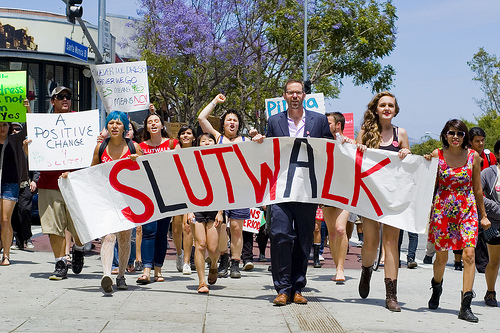 Compare and Contrast the Different Strands of Feminism -Radical feminists reject the public-private split - the idea that there is, or should be, a division between the spheres of public, economic and political activity and the private areas of the home and the family- a split which liberals accept and even value. -Whereas liberal feminists believe encroaching upon the private sphere may amount to creeping totalitarianism for radical feminists the priority is a sexual revolution which will eliminate private patriarchy. -Although Marxists feminists advocate revolutionary means of bringing about gender equality, they differ from the radicals in their believe that the said revolution will take place in the public sphere. -Liberals are inherently reformist -The strands of feminism all agree that biological, economic and cultural factors all play a role in gender inequality but disagree on the relative importance of those factors and upon the solutions. -There are internal divides with radical feminism as a number believe the women should seize control of the means of production whilst others advocated political separatism whilst the extremist believe in private as well as public separatism in the form of political lesbianism. -A minority of radical feminists insists upon the superiority of female traits and values - so called 'supremacists' whose goal is matriarchy rather than equality. -Black and third world feminists, meanwhile, stress the great diversity of women in and across culture, and often criticizes first world feminists of all schools for racism. The experiences of a successful, white, Western, professional woman would truly alien to a black working class women battling against racism and poverty as well as sexism. |
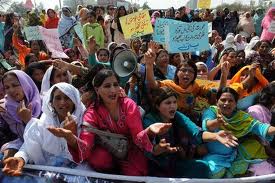 Statistics -The pay gap between full-time men’s and women’s median earnings stands at 10.5 per cent, whereas the overall gap when comparing the pay of all men and women in work is 20.2 per cent- According to the Home Office -22.2 per cent members of parliament are women, yet 51 per cent of the population are women -1.2 per cent of MPs are Black, Asian and minority ethnic women yet 5.6 per cent of the population are Black, Asian and minority ethnic women |



